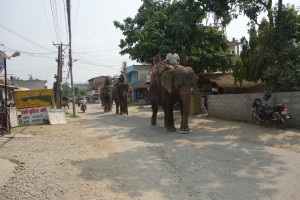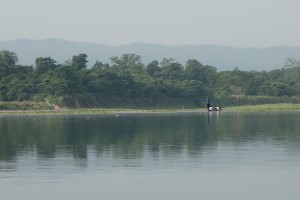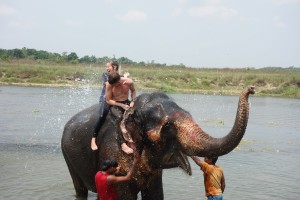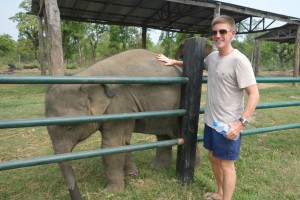Sauraha, a gathering of guest houses and souvenir shops in the tropical Terai region of Nepal, is the gateway to Chitwan National Park. It comprises a dusty road with very few vehicles, much of the traffic being elephants, camels and pony-and-traps, leading onto a snoozy river which forms the Northern boundary of the park.
Most people use the town solely as a base to explore the park, arriving on 2 or 3 night package tours, but we saw some potential here for a little R&R. We found a high-end hotel that let us use their luxuriant swimming pool, sunk into a lush garden that attracted all sorts of jungle birds and had an elephant stable. So while some of our fellow tourists were done up like Stanley off to explore Africa, we ambled around in beach clobber, clutching a bag full of paperbacks and bottled water.
 Certainly we weren’t so lazy as to disregard the park altogether. We opted for a morning ride in a dug-out canoe where it felt like we were floating down some tributary of the Amazon. The banks were lined with rushes and high grass, amongst which we saw a twitcher’s wet dream of birds: egrets, ibis, kingfisher, huge maribou stork and even bigger peacocks. Our guide floated us through the lilipads and vegetation close to the bank. “Crocodile!” he whispered urgently, pointing. None of us had seen it so he laboriously punted the canoe backwards. This time we saw it, about 2 feet underwater, the back half of an enormous man-eater, it’s tail as thick and long as a man’s leg, hiding like some relic of prehistory.
Certainly we weren’t so lazy as to disregard the park altogether. We opted for a morning ride in a dug-out canoe where it felt like we were floating down some tributary of the Amazon. The banks were lined with rushes and high grass, amongst which we saw a twitcher’s wet dream of birds: egrets, ibis, kingfisher, huge maribou stork and even bigger peacocks. Our guide floated us through the lilipads and vegetation close to the bank. “Crocodile!” he whispered urgently, pointing. None of us had seen it so he laboriously punted the canoe backwards. This time we saw it, about 2 feet underwater, the back half of an enormous man-eater, it’s tail as thick and long as a man’s leg, hiding like some relic of prehistory.
A little farther on we happened across a full-grown male rhino bathing, rolling every now and again to wet it’s impenetrable armoured skin. It regarded us with one wrinkly eye and decided we were alright. We had clambered into the jungle to get a better look, and walked back to the park entrance. The only other wildlife we saw were skitterish deer, the thundering of their hooves belying their position in the dense forest, and also some deep scratches in the bark of trees where a tiger had marked out his territory.
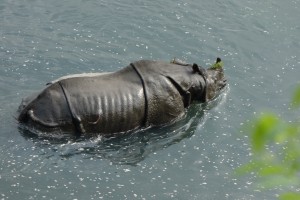
The locals seem to have a strange co-existence with the animals of the forest. On the one hand, they are protected species, they are what draw the tourists and, more than that, the people seem truly proud of them. But then there is the killing. One tiger has killed 10 locals, a wild elephant another 20, crocodiles take a bite here and there, even sloth bears don’t just watch from the sidelines. The government disallow any sort of retaliation, and there are several army checkposts to enforce this (also to dissuade poachers who slaughter rhinos for the – you guessed it – Chinese market), so the villagers just accept the situation.
Our guest house clearly wanted us to leave when they realised we weren’t going to book any more tours, but we ended up staying 5 nights. We just couldn’t tear ourselves away – where else can you sit beneath a thatched riverside bamboo gazebo, drinking 2-for-1 cocktails and eating curried catfish (caught fresh from the river), watching the sun sink into a misty rain-forest, while elephants wash themselves, lizards flitter around, and a man-eating crocodile crosses stealthily beneath you?

